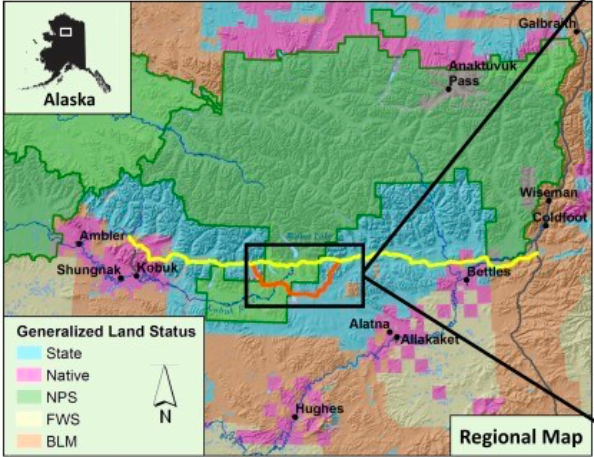PUBLIC COMMENT PERIOD OPEN FOR ACCESS TO JOB-PRODUCING ROAD
The Ambler Mining District Industrial Access Road has been on the planning table for years, with the Alaska Industrial Development and Export Authority estimates an annual average of approximately 486 jobs to be created during the road construction period and up to 68 full-time jobs for road operations and maintenance over the life of the road.
The road would originate at the Dalton Highway near Prospect Creek and end at the AmblerMining District, and would have no public access.
Sixty-eight road jobs is a lot of jobs in a part of the state that has next-to-nothing in the way of job opportunity.
Now, the Draft Environmental Impact Statement for the proposed Ambler Mining District Industrial Access Road is done and available for public comment at the Bureau of Land Management Alaska’s website.
The Alaska Industrial Development and Export Authority is proposing an industrial access road connecting the Dalton Highway to the Ambler mineral belt in the Kobuk Valley, facilitating resource development and economic opportunities for Alaska.
As with AIDEA’s DeLong Mountain Transportation System, any mines using the road to haul ore to the Dalton Highway would pay a toll that would pay back the AIDEA financing used for the development and construction of the road. The DeLong Mountain Transportation System allowed the development of the Red Dog Mine.
The Ambler road would stretch 211-mile and be open all season to access mineral exploration in the area. It would cross 61 percent state land, 15 percent Alaska Native corporation land, and 24 percent federal BLM land National Park Service land.
Unlike the long-desired 11-mile road from King Cove to the all-weather airport on the other side of the Izembek National Wildlife Refuge, surface transportation across the Gates of Arctic National Park and Preserve was specifically detailed in the Alaska National Interest Lands Conservation Act and the Secretary of the Interior must permit access.
ANILCA requires all appropriate federal agencies outside the National Park Service to work cooperatively on a single environmental analysis and concurrently issue a decision on the proposal.
“The BLM conducted extensive public outreach for this project and visited many remote communities that would be most affected by the road,” said BLM Alaska State Director Chad Padgett. “I realize the importance of this project to the State of Alaska and for the state’s ability to develop its resources and as such, I am committed to ensuring a thorough and comprehensive analysis. This can’t be done without substantive input from stakeholders.”
Public meetings about the Draft EIS are scheduled in Alatna, Allakaket, Ambler, Anaktuvuk Pass, Anchorage, Bettles, Coldfoot, Evansville, Fairbanks, Hughes, Huslia, Kiana, Kobuk, Kotzebue, Noatak, Noorvik, Selawik, Shungnak, Stevens Village, Tanana, Wiseman and Washington, D.C. The dates, times and locations of the meetings will be announced in advance through public releases and the BLM Alaska website and social media.
The Draft EIS published in the Federal Register on Aug. 23, 2019, triggering a 45-day public comment period that ends Oct. 7.
Comments can be submitted in the following ways:
- Online at https://www.blm.gov/AmblerRoadEIS
- By mail to Ambler Road DEIS Comments, BLM Fairbanks District Office, 222 University Avenue, Fairbanks AK 99709
- By hand to BLM, 222 University Avenue, Fairbanks, Alaska 99709
Documents may be examined at the Bureau of Land Management Alaska State Office, BLM Alaska Public Information Center, 222 West 7th Avenue, Anchorage or at the Bureau of Land Management Fairbanks District Office, 222 University Avenue., Fairbanks.
The National Park Service has prepared its own Draft Environmental and Economic Analysis for the portion of the proposed Ambler Road that crosses National Park Service lands. That document is available at this link for a review period concurrent with the Bureau of Land Management’s draft EIS.
